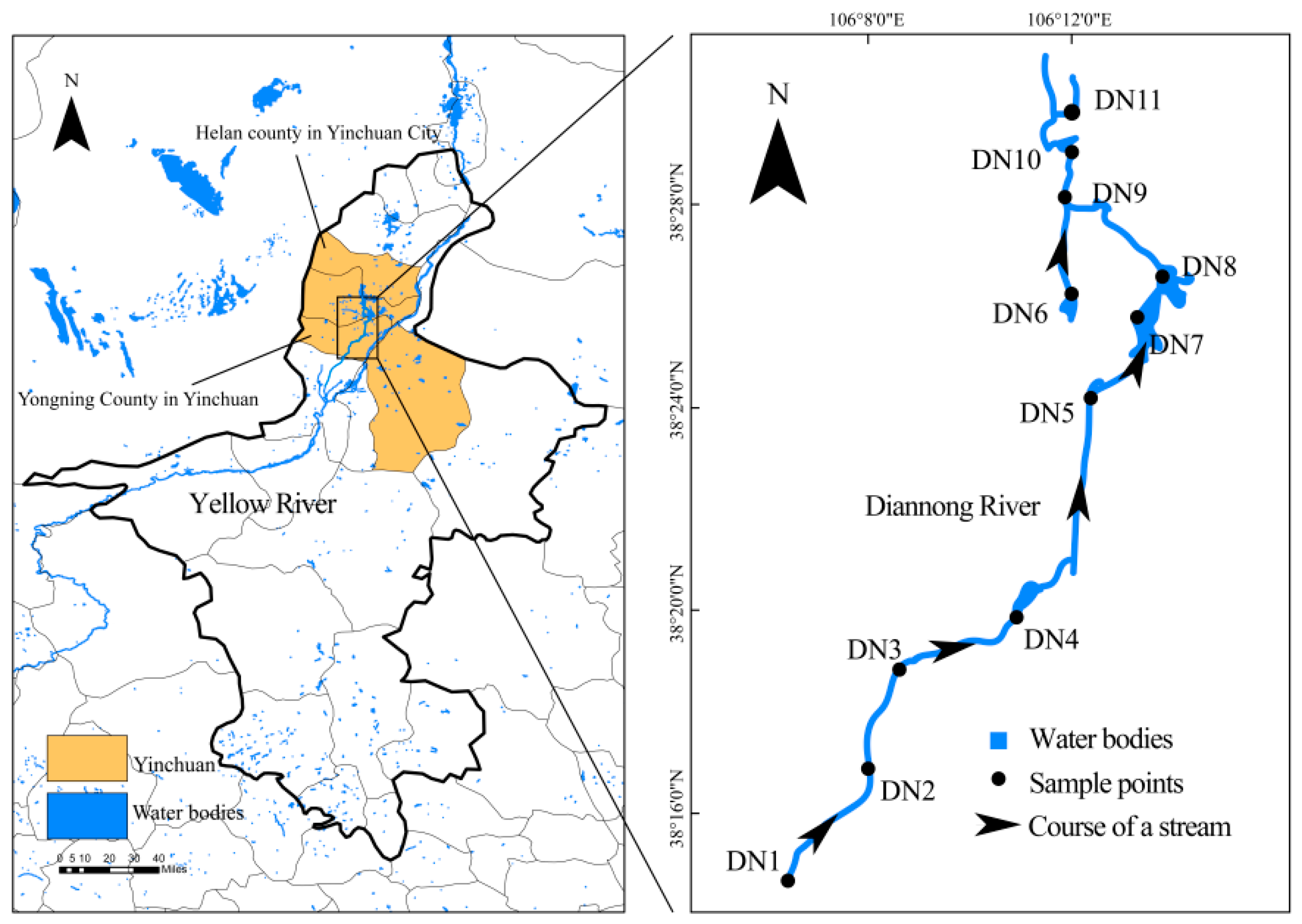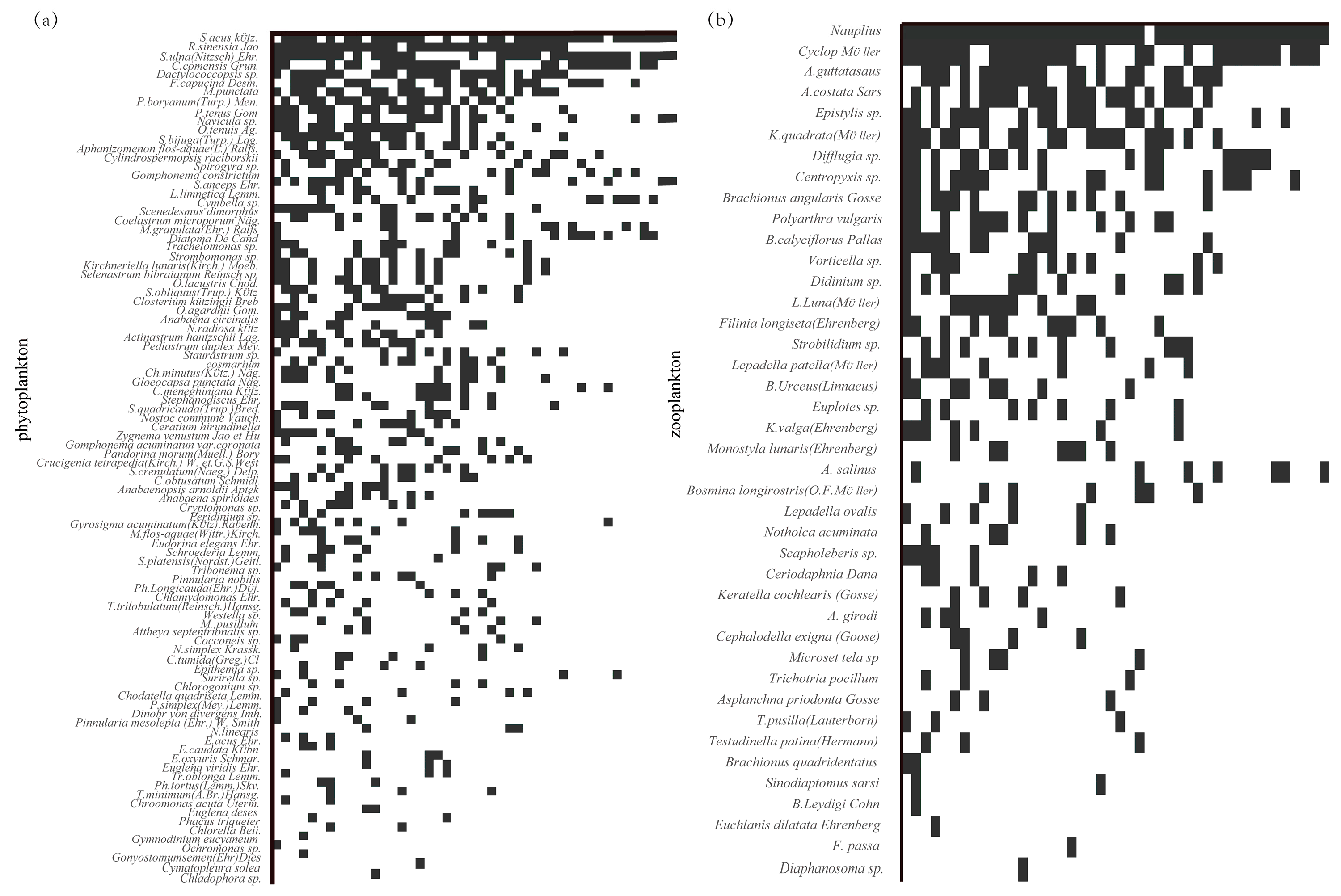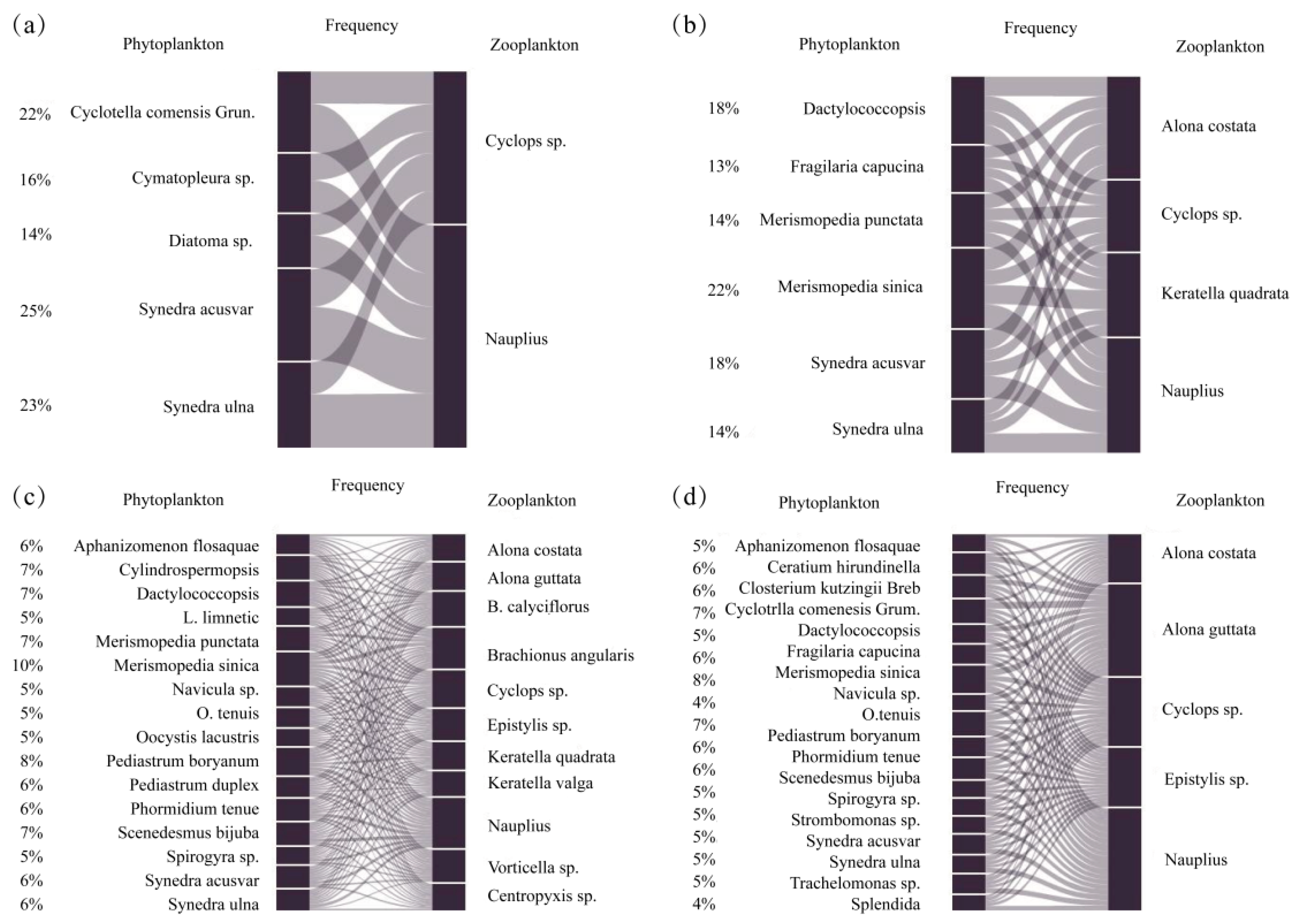Nested Patterns of Phytoplankton and Zooplankton and Seasonal Characteristics of Their Mutualistic Networks: A Case Study of the Upstream Section of the Diannong River in Yinchuan City, China
Abstract
:1. Introduction
2. Materials and Methods
2.1. Overview of the Study Area
2.2. Sample Points Deployment and Sampling Time
2.3. Sample Collection and Experimental Methods
2.4. Construction of the Plankton Dichotomous Network and Its Analysis
2.5. Data Analysis Methods
3. Results
3.1. Spatial and Temporal Characteristics of Water Quality
3.2. Plankton Community Composition and Its Diversity
3.3. Nested Patterns of Planktonicity
3.4. Plankton Interaction Network Relationships
3.5. Correlation Analysis between Plankton and Water Environment Factors
4. Discussion
4.1. Plankton Composition and Its Diversity in the Upper Section of the Diannong River
4.2. Nested Structure of Plankton in the Upper Section of the Diannong River
4.3. Seasonal Characteristics of the Interaction Network between Phytoplankton and Zooplankton in the Upper Section of the Diannong River
4.4. Correlation between Plankton and Water Environment Factors in the Upstream Section of the Diannong River
5. Conclusions
Author Contributions
Funding
Institutional Review Board Statement
Informed Consent Statement
Data Availability Statement
Acknowledgments
Conflicts of Interest
References
- Hou, E.G.; Shang, S.Q.; Guan, S.S.; Sun, S.H.; Bai, H.F.; Yin, X.W. Spatial and temporal distribution and functional group characteristics of plankton community in Jixi wetland, Jinan City. J. Dalian Ocean Univ. 2023, 38, 482–493. [Google Scholar] [CrossRef]
- Lin, J.N.; Ming, H.X.; Zhang, Q.L.; Fan, F.J. Marine plankton-associated transmission of vibrios: A review. Microbiol. China 2023, 50, 4681–4693. [Google Scholar] [CrossRef]
- Xu, S.S.; Liu, F.; Chen, S.Y.; Zhang, Y.J.; Chen, L.J. Correlation analysis of macrobenthos community structure with plankton and environmental factors in the Chaiqu Zangbo Basin in Tibet. Acta Sci. Circumst. 2023, 43, 418–427. [Google Scholar] [CrossRef]
- Yang, Y.; Niu, H.Y.; Xiao, L.J. Spatial heterogeneity of spring phytoplankton in a large tropical reservoir: Could mass effect homogenize the heterogeneity by species sorting? Hydrobiologia 2018, 819, 109–122. [Google Scholar] [CrossRef]
- Liu, Y.L. Temperature and nutrients are significant drivers of seasonal shift in phytoplankton community from a drinking water reservoir, subtropical China. Environ. Sci. Pollut. Res. 2014, 21, 5917–5928. [Google Scholar] [CrossRef]
- Elliott, J.A. The seasonal sensitivity of Cyanobacteria and other phytoplankton to changes in flushing rate and water temperature. Glob. Change Biol. 2010, 16, 864–876. [Google Scholar] [CrossRef]
- Cottingham, K.L.; Carpenter, S. Population, community, and ecosystem variates as ecological indicators: Phytoplankton responses to whole-lake enrichment. Ecol. Appl. 1998, 8, 508–530. [Google Scholar] [CrossRef]
- Reynolds, C.S.; Padisák, J.; Sommer, U. Intermediate disturbance in the ecology of phytoplankton and the maintenance of species diversity: A synthesis. Hydrobiologia 1993, 249, 183–188. [Google Scholar] [CrossRef]
- Bess, Z.; Chandra, S.; Suenaga, E. Zooplankton influences on phytoplankton, water clarity, and nutruents in Lake Tahoe. Aquat. Sci. 2021, 83, 1–15. [Google Scholar] [CrossRef]
- Yuan, Y.X.; Jiang, M.; Liu, X.T.; Yu, H.; Otte, M.L.; Ma, C.; Her, Y.G. Environmental variables influencing phytoplankton communities in hydrologically connected aquatic habitats in the Lake Xingkai Basin. Ecol. Indic. 2018, 91, 1–12. [Google Scholar] [CrossRef]
- Liu, C.R.; Ma, K.P.; Chen, L.Z. Nestedness: Methods, mechanisms and implications for biological conservation. Chin. J. Plant Ecol. 2002, 26, 68–72. [Google Scholar] [CrossRef]
- Patterson, B.D.; Atmar, W. Nested subsets and the structure of insular mammalian faunas and archipelagos. Biol. J. Linn. Soc. 1986, 28, 65–82. [Google Scholar] [CrossRef]
- Atmar, W.; Patterson, B.D. The measure of order and disorder in the distribution of species in fragmented habitat. Oecologia 1993, 96, 373–382. [Google Scholar] [CrossRef]
- Lin, L.T.; Ma, K.M. Selection of nullmodels in nestedness pattern detection of highly asymmetric mycorrhizal networks. Chin. J. Plant Ecol. 2019, 43, 611–623. [Google Scholar] [CrossRef]
- Bastolla, U.; Fortuna, M.A.; Pascual-Garcia, A.; Ferrera, A.; Luque, B.; Bascompte, J. The architecture of mutualistic networks minimizes competition and increases biodiversity. Nature 2009, 458, 1018–1020. [Google Scholar] [CrossRef] [PubMed]
- Thebault, E.; Fontaine, C. Stability of ecological communities and the architecture of mutualistic and trophic networks. Science 2010, 329, 853–856. [Google Scholar] [CrossRef] [PubMed]
- Yang, F.; Liu, Z.; Yang, G.S.; Feng, G. Dominated Taxonomic and Phylogenetic Turnover but Functional Nestedness of Wetland Bird Beta Diversity in North China. Land 2022, 11, 1090. [Google Scholar] [CrossRef]
- Li, Z.; Lu, Z.; Shu, X.; Jiang, G.; Xu, L.; Zhou, F. Nestedness of bird assemblages in the karst forest fragments of southwestern Guangxi, China. Avian Res. 2022, 30, 92–102. [Google Scholar] [CrossRef]
- Clémençon, P.; Letourneur, D.; Ratchinski, P. A plant, a caterpillar, a wasp, and symbiotic microorganisms: Nested multitrophic interactions. Med. Sci. 2019, 35, 586–588. [Google Scholar] [CrossRef]
- Atunnisa, R.; Ezawa, T. Nestedness in arbuscular mycorrhizal fungal communities in a volcanic ecosystem, Selection of disturbance-tolerant fungi along an elevation gradient. Microbes Environ. 2019, 34, 327–333. [Google Scholar] [CrossRef]
- Aparicio-Rizo, P.; Munoz, G. Spatial and temporal variation of the endoparasite community structure of intertidal fishes incentral Chile, parasitological descriplors, species composition and nestedness. Lat. Am. J. Aquat. Res. 2017, 45, 737–747. [Google Scholar] [CrossRef]
- Yu, W.Z.; Yang, D.D.; Ji, M.D.; Bao, H.; Huang, Y.H.; Qu, D.; Ma, S.R.; Han, D.Q.; Fan, W.J. Patial distribution of plankton community in Shahe Reservoir and eutrophication assessment after low water level operation. Acta Sci. Circumst. 2022, 42, 94–102. [Google Scholar] [CrossRef]
- Bai, H.F.; Wang, Y.R.; Song, J.X.; Kong, F.H.; Zhang, X.X.; Li, Q. Characteristics of Plankton Community Structure and lts Relation to Environmental Factors in Weihe River China. Ecol. Environ. Sci. 2022, 31, 117–130. [Google Scholar] [CrossRef]
- Duan, X.M.; Qin, H.W.; Ma, H.Y.; Xu, Z.H.; Lv, H.R.; Liang, S.K. Temporospatial Distribution of Phosphorus and Response of Phytoplankton to Low Phosphoru: Stress in the Yellow River Estuary and Laizhou Bay. Period. Ocean Univ. China 2023, 53, 87–98. [Google Scholar] [CrossRef]
- Li, H.D.; Wu, X.W.; Xiao, Z.S. Assembly, ecosystem functions, and stability in species interaction networks. Chin. J. Plant Ecol. 2021, 45, 1049–1063. [Google Scholar] [CrossRef]
- Vorste, R.V.; Stubbington, R.; Acua, V.; Bogan, M.T.; Ruhí, A. Climatic aridity increases temporal nestedness of invertebrate communities innaturally drying rivers. Ecography 2021, 44, 860–869. [Google Scholar] [CrossRef]
- Tang, L.Q.; Chi, W.D.; Lv, F.; Gai, S.S.; Liu, W.; Wang, X.Y.; He, Q.; Ding, G. Seasonal Variation and Interrelationship of MarinePlankton and Benthos in Changdao Island. Sea. Period. Ocean. Univ. China 2023, 1–10. [Google Scholar] [CrossRef]
- Zhou, F.X.; Chen, J.H. Atlas of Freshwater Microorganisms; Chemical Industry Press: Beijing, China, 2010. [Google Scholar]
- Wei, Y.X.; Hu, H.Y. Freshwater Algae of China—System, Taxonomy and Ecology; Science Press: Beijing, China, 2006. [Google Scholar]
- Ning, X.Y.; Zhang, L.; Chen, K.Q.; Han, C.A.; Li, Q.S.; Li, K.Y.; He, H.; Zhao, B.Y. Effects of Exopalaemon modestus on nutrient levels and plankton communities in spring and Summel subtropical lakes and reservoirs: A microcosm experiment. J. Lake Sci. 2022, 34, 582–589. [Google Scholar] [CrossRef]
- Wan, L.L.; Chen, Z.F.; Guo, J.; Tong, L.H.; Ren, L.J.; Han, B.P.; Wu, Q.L. Principle and application of co-occurrence networks for freshwater ecosystem assessment. J. Lake Sci. 2022, 34, 1765–1789. [Google Scholar] [CrossRef]
- Hu, J.J.; Xue, L.Y.; Pang, W.J.; Yan, C.L.; Pei, G.F. Response of Submerged Macrophyte and Filamentous Green Algae to Nitrogen and Phosphorus Loads. Environ. Sci. Technol. 2023, 1–11. Available online: http://kns.cnki.net/kcms/detail/42.1245.X.20230913.0909.002.html (accessed on 28 September 2023).
- Soininen, J.; Paavola, R.; Muotka, T. Benthic diatom communities in boreal streams, community structure in relation to environmental and spatial gradients. Ecography 2004, 27, 330–342. [Google Scholar] [CrossRef]
- Xie, J.; Su, Y.L.; Wu, B.; Zhang, Y.; Xiao, L.J.; Gu, J.G. Responses of phytoplankton communities to N-P-Fe enrichments in wet season of tropical reservoirs in southern China: A case study of Dashahe Reservoir, Guangdong Province. J. Lake Sci. 2023, 1–11. Available online: http://kns.cnki.net/kcms/detail/32.1331.P.20231012.1623.004.html (accessed on 28 September 2023).
- Yan, J.; Xu, Z.J.; Li, T.J.; Wang, H.J.; Zhang, Y.B.; Qian, H. Spatiotemporal dynamics of larvae and juveniles in zhoushan coastal waters and their relationship with environmental factors. Oceanol. Limnol. Sin. 2023, 54, 799–810. [Google Scholar] [CrossRef]
- Yin, S.M.; Xing, L.Z.; Zhang, P.Y.; Duan, Y.W. Stability Analysis of Production Networks in the Asia-Pacific Region Based on Nested Structure Theory. Syst. Eng. Theory Pract. 2023, 1–22. Available online: http://kns.cnki.net/kcms/detail/11.2267.N.20230907.1621.010.html (accessed on 28 September 2023).
- Bohnenberger, J.E.; Schneck, F.; Crossetti, L.O.; Sonaira, L.M.; Da, M.M.D. Taxonomic and functional nestedness patterns of phytoplankton communi-ties among coastal shallow lakes in southern Brail. J. Plankton Res. 2018, 40, 555–567. [Google Scholar] [CrossRef]
- Wang, X.; Wang, Y.P.; Ding, P. Nested species subsets of amphibians and reptiles in Thousand Island Lake. Zool. Res. 2012, 33, 439–446. [Google Scholar] [CrossRef]
- Heino, J.; Soininen, J.; Alahuhta, J.; Lappalainen, J.; Virtanen, R. Metacommunity ecology meets biogeography, effects of geographical region, spatial dynamics and environmental filtering on community structure in aquatic organisms. Oecologia 2017, 183, 121–137. [Google Scholar] [CrossRef] [PubMed]
- Ramos-Jiliberto, R.; Oyanedel, J.P.; Vega-Retter, C.; Valdovinos, F.S. Nested structure of plankton communities from Chilean freshwaters. Limnologica 2009, 39, 319–324. [Google Scholar] [CrossRef]
- Qin, G.L.; Du, G.Z. Effect of species diversity on temporal variability of ecosystem function. Ecol. Sci. 2005, 2, 158–161. [Google Scholar] [CrossRef]
- Yang, M.; Bi, Y.H.; Hu, J.L. Diel vertical migration and distribution of phytoplankton during spring blooms in Xiangxi Bay, Three Gorges Reservoir. Lake Sci. 2011, 23, 375–382. [Google Scholar]
- Wei, G.L.; Zhang, S.C.; Cai, Z.H.; Zhou, J. Research pogress and ecological roles of phytoplankton cysts. Chin. J. Appl. Ecol. 2020, 31, 685–694. [Google Scholar] [CrossRef]
- Dai, M.X.; Zhu, Y.F.; Lin, X.; Mao, S.Q. Interpretation of environmental factors affecting zooplanktonic beta diversity and its components in Xiangshan Bay. Acta Ecol. Sin. 2017, 37, 5780–5789. [Google Scholar] [CrossRef]
- Walker, C.E.; Pan, Y.D. Using diatom assemblages to assess urban stream conditions. Hydrobiologia 2006, 516, 179–189. [Google Scholar] [CrossRef]
- Wu, M.L.; Wang, Y.S.; Sun, C.C.; Wang, H.L.; Dong, J.D.; Han, S.H. identification of anthropogenic effects and seasonality on water quality in Daya Bay, south China Sea. J. Environ. Manag. 2009, 90, 3082–3090. [Google Scholar] [CrossRef]
- Chavez-Gonzleza, E.; Vizentin-Bugoni, J.; Vizquez, D.P. Drivers of the structure of plant-hummingbird interaction net-works at multiple temporal scales. Oecologia 2020, 193, 913–924. [Google Scholar] [CrossRef] [PubMed]
- Id, O.C.; Arnan, X.; Bassols, E.; Narcís Vicens Bosch, J. Seasonal dynamics in a cavity-nesting bee-wasp community, Shifts in composition, functional diversity and host-parasitoid network structure. PLoS ONE 2019, 13, e0205854. [Google Scholar] [CrossRef]
- Robinson, S.; Losapio, G.; Henry, C. Flower-power, Flower diversity is a stronger predlictor of network stnucture than in-sect diversity in an Arctic plant-pollinator network. Ecol. Complex. 2018, 36, 1–6. [Google Scholar] [CrossRef]
- Wang, Y.R.; Xu, T.T.; Dong, W.T.; Yu, H.X. Phytoplankton Community Characteristics and Water Quality Assessment in Songbei National Wetland Park, Harbin. J. Northeast. For. Univ. 2023, 51, 71–76. [Google Scholar]
- Chen, F.; Meng, S.L.; Chen, J.Z.; Qiu, L.P.; Fan, L.M.; Song, C.; Zhen, Y.; Li, D.D.; Hu, G.D. Transmissibility characteristics of methomvl in chlorella-water fleas-zebrafish food chain. J. Dalian Ocean Univ. 2022, 37, 784–792. [Google Scholar] [CrossRef]
- Chen, Z.D.; Huang, L.P.; Chen, L.; Liang, H.; Liu, Y.Y.; Chen, X.L.; Zhang, T.; Chen, G.J. Seasonal variation and driving factors of carbon and nitrogen stable isotope values of plankton in four lakes of Yunnan Province. Lake Sci. 2021, 33, 761–773. [Google Scholar] [CrossRef]
- Tao, M.; Yue, X.J.; Yue, S.; Dai, L.N.; Han, W.W.; Wang, Y.M.; Liu, G.; Li, B. Phytoplankton community structure and cyanobacteria bloom risk of reservoirs in hilly regions of Sichuan Province based on dominant species niche and interspecific association. Acta Ecol. Sin. 2021, 41, 9457–9469. [Google Scholar] [CrossRef]
- Li, Y.P.; Li, Y.L.; Fu, J.; Yu, X.G.; Zou, C.J. Niche characteristics of macrobenthic community in the intertidal zone on the west coast of Liaodong Bay. Mar. Sci. 2019, 43, 32–39. [Google Scholar]
- Hu, Y.; Zhang, Y.Z.; Jiang, X.Y.; Sao, K.Q.; Tang, Y.M.; Gao, G. Seasonal characteristics of nestedness pattern and interaction of plankton assemblages in East Lake Taihu. J. Lake Sci. 2022, 34, 1620–1629. [Google Scholar] [CrossRef]
- George, J.A.; Lonslale, D.J.; Merlo, L.R.; Gobler, C.J. The interactive moles of temperature, nutrients, and zooplankton grazing in con-trolling the winter-spring phytoplankton bloom in a temperate, coastal ecosystem, Long Island Sound. Limnol. Oceanogr. 2015, 60, 110–126. [Google Scholar] [CrossRef]
- Zhao, M.; Jiao, S.L.; Liang, H. Eutrophication of Lakes in Karst Plateau Based on the Comprehensive Trophic State index Method. J. China Hydrol. 2020, 40, 9–15. [Google Scholar] [CrossRef]
- Gao, J.T.; Wu, F.S.; He, G.H.; Yang, W.H. Phytoplankton Community Characteristics and Environmental Driving Factors of Urban Lakes in Cold Regions. Environ. Sci. Technol. 2021, 44, 1–10. [Google Scholar] [CrossRef]
- Pang, Y.J.; Zhao, W.; Wei, J.; Fan, J.J.; Yin, D.P.; Wang, P.A.; Xie, Z.G. Comparison of plankton community structure and water environment characteristics between Huanren Reservoir and Biliuhe Reservoir. J. Dalian Ocean Univ. 2020, 35, 407–416. [Google Scholar]
- Xu, H.; Paerl, H.W.; Qin, B.; Zhu, G.; Gaoa, G. Nitrogen and Phosphonus Inputs Control Phytoplankton Growth in Eutrophic Lake Taihu, China. Limnol. Oceanogr. 2010, 55, 420–432. [Google Scholar] [CrossRef]
- Wang, H.; Yang, S.P.; Fang, S.Z.; Yu, F.C.; Feng, W.B.; Liu, L.P. Canonical correspondence analysis of relationship between characteristics of phytoplankton communit and environmental factors in Dianchi Lake. China Environ. Sci. 2016, 36, 544–552. [Google Scholar] [CrossRef]
- Da, W.Y.; Zhu, G.W.; Wu, Z.X.; Li, Y.X.; Xu, H.; Zhu, M.Y.; Lan, J.; Zhen, W.T.; Zhang, Y.L.; Qin, B.Q. Long-term variation of phytoplankton community and driving factors in Qiandaohu Reservoir, southeast China. J. Lake Sci. 2019, 31, 1320–1333. [Google Scholar]





| Environmental Parameters | January | April | July | October | Statistical Significance |
|---|---|---|---|---|---|
| WT (°C) | 3.1 ± 1.7 | 4.1 ± 0.7 | 22.1 ± 0.3 | 14.1 ± 1.3 | *** |
| Cond (µS/cm) | 911 ± 400 | 1445 ± 656 | 998 ± 273 | 2298 ± 1803 | * |
| DO (mg/L) | 14 ± 3 | 9 ± 1 | 9 ± 2 | 5.6 ± 0.4 | *** |
| Sal (ppt) | 0.8 ± 0.4 | 0.7 ± 0.3 | 0.5 ± 0.1 | 1.3 ± 1.0 | ** |
| TDS (mg/L) | 1073 ± 468 | 878 ± 403 | 592 ± 163 | 1586 ± 1248 | ** |
| pH | 8.3 ± 0.2 | 7.5 ± 0.1 | 8.3 ± 0.3 | 8.2 ± 0.2 | *** |
| TN (mg/L) | 3.8 ± 3.7 | 0.6 ± 0.5 | 1.2 ± 1.1 | 4.3 ± 3.6 | ** |
| NH4+-N (mg/L) | 0.36 ± 0.15 | 0.44 ± 0.34 | 0.36 ± 0.33 | 0.33 ± 0.28 | ** |
| TP (mg/L) | 0.05 ± 0.02 | 0.04 ± 0.02 | 0.03 ± 0.01 | 0.03 ± 0.01 | * |
| AP (mg/L) | 0.01 ± 0.01 | 0.005 ± 0.002 | 0.0011 ± 0.0002 | 0.025 ± 0.025 | *** |
| CODMn (mg/L) | 2.5 ± 1.1 | 3.9 ± 1.6 | 4.5 ± 1.9 | 3.9 ± 2.1 | ** |
| CODCr (mg/L) | 16.7 ± 10.3 | 15.5 ± 10.1 | 26.3 ± 20.6 | 15.3 ± 7.5 | ns |
| F− (mg/L) | 3.8 ± 2.5 | 1.2 ± 0.9 | 0.8 ± 0.4 | 1.1 ± 0.7 | *** |
| Cl− (mg/L) | 929 ± 536 | 470 ± 375 | 294 ± 121 | 807 ± 705 | *** |
| SO42− (mg/L) | 346 ± 333 | 300 ± 235 | 216 ± 115 | 558 ± 488 | ns |
| Chl.a (mg/L) | 31 ± 21 | 27 ± 14 | 6.5 ± 3.3 | 32 ± 26 | *** |
| Month | Zooplankton | Phytoplankton | Frequency |
|---|---|---|---|
| January | Nauplius | Cyclotella comensis Grun. | 9 |
| Nauplius | Synedra acusvar | 10 | |
| Nauplius | Synedra ulna | 10 | |
| April | Alona costata | Merismopedia sinica | 9 |
| Nauplius | Merismopedia sinica | 10 | |
| Nauplius | Synedra acusvar | 9 | |
| July | Nauplius | Pediastrum boryanum | 9 |
| Nauplius | Dactylococcopsis | 9 | |
| Nauplius | Merismopedia sinica | 11 | |
| Brachionus angularis | Merismopedia sinica | 9 | |
| October | Nauplius | Cyclotella comensis Grun. | 9 |
| Nauplius | Oithona tenuis | 9 | |
| Nauplius | Merismopedia sinica | 10 | |
| Alona guttata | Cyclotella comensis Grun. | 9 | |
| Alona guttata | Merismopedia sinica | 9 |
Disclaimer/Publisher’s Note: The statements, opinions and data contained in all publications are solely those of the individual author(s) and contributor(s) and not of MDPI and/or the editor(s). MDPI and/or the editor(s) disclaim responsibility for any injury to people or property resulting from any ideas, methods, instructions or products referred to in the content. |
© 2023 by the authors. Licensee MDPI, Basel, Switzerland. This article is an open access article distributed under the terms and conditions of the Creative Commons Attribution (CC BY) license (https://creativecommons.org/licenses/by/4.0/).
Share and Cite
Meng, J.; Zhao, R.; Qiu, X.; Liu, S. Nested Patterns of Phytoplankton and Zooplankton and Seasonal Characteristics of Their Mutualistic Networks: A Case Study of the Upstream Section of the Diannong River in Yinchuan City, China. Water 2023, 15, 4265. https://doi.org/10.3390/w15244265
Meng J, Zhao R, Qiu X, Liu S. Nested Patterns of Phytoplankton and Zooplankton and Seasonal Characteristics of Their Mutualistic Networks: A Case Study of the Upstream Section of the Diannong River in Yinchuan City, China. Water. 2023; 15(24):4265. https://doi.org/10.3390/w15244265
Chicago/Turabian StyleMeng, Junjie, Ruizhi Zhao, Xiaocong Qiu, and Shuangyu Liu. 2023. "Nested Patterns of Phytoplankton and Zooplankton and Seasonal Characteristics of Their Mutualistic Networks: A Case Study of the Upstream Section of the Diannong River in Yinchuan City, China" Water 15, no. 24: 4265. https://doi.org/10.3390/w15244265
APA StyleMeng, J., Zhao, R., Qiu, X., & Liu, S. (2023). Nested Patterns of Phytoplankton and Zooplankton and Seasonal Characteristics of Their Mutualistic Networks: A Case Study of the Upstream Section of the Diannong River in Yinchuan City, China. Water, 15(24), 4265. https://doi.org/10.3390/w15244265






